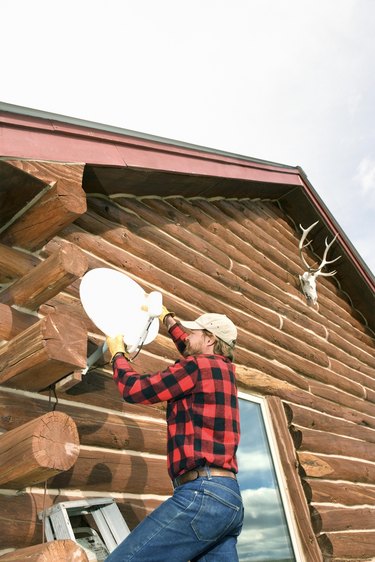Things You'll Need
Calculator
Tape measure

Wind load is the amount of stress on an object at a given wind speed. Wind load must be considered when installing a satellite dish; otherwise you could end up with a bent pole or retrieving the dish from miles away after a storm. The basic formula for calculating wind load is as follows: area multiplied by pressure per square foot multiplied by drag coefficient equals force. Determining the wind's force, however, is not this straightforward because wind speeds are erratic and influenced by terrain and structures close to the ground. The solution is to determine the possible wind load and then overcompensate for it when installing your dish. Never underestimate nature's destructive power.
Step 1
Calculate the wind's force by squaring the wind speed in miles per hour and multiplying the answer by 0.00256. Wind speed zones in most of the continental United States are either 70 or 80 miles per hour, but you may need to increase this number based on your location.
Video of the Day
For a 80 mph wind, the calculation would be: 80 X 80 X 0.00256 = 16.384
This number is the amount of pressure, per square foot, of an 80 mph wind.
Step 2
Multiply the number determined Step 1 by the dish's surface area. With an 80 mph wind and a structure with a surface area of 10 square feet, the calculation is: 16.384 X 10 = 163.84
Measure the actual surface area of the dish for this equation. Do not rely on the dish's manufacturer's specifications because they can vary by up to 3 inches.
Mesh satellite dishes exert approximately 40 percent less force than a solid dish up to 50 mph. Over 50 mph, the mesh dish will act the same way as a solid dish. This is because the high wind flow creates turbulence around the holes in the mesh and prevents the wind from passing through. Any decrease in wind load on mesh dishes at low wind speeds is lost once winds reach higher than 50 mph. Treat mesh dishes similar to solid ones.
Step 3
Multiply the answer from Step 2 by the structure's drag coefficient. For a round dish, use 1.2 for the drag coefficient. For a dish with a surface area of 10 square feet, an 80 mph wind would create a wind load of: 163.84 X 1.2 = 196.61 pounds.
Warning
The formula above should be used only for rough estimates as many other factors, such as air temperatures and altitude, affect wind pressure; consult a civil or structural engineer for specific advice. Failing to properly consider wind loads when installing a satellite dish can result in damage to the dish, damage to surrounding structures and loss of life during a wind storm.
Video of the Day